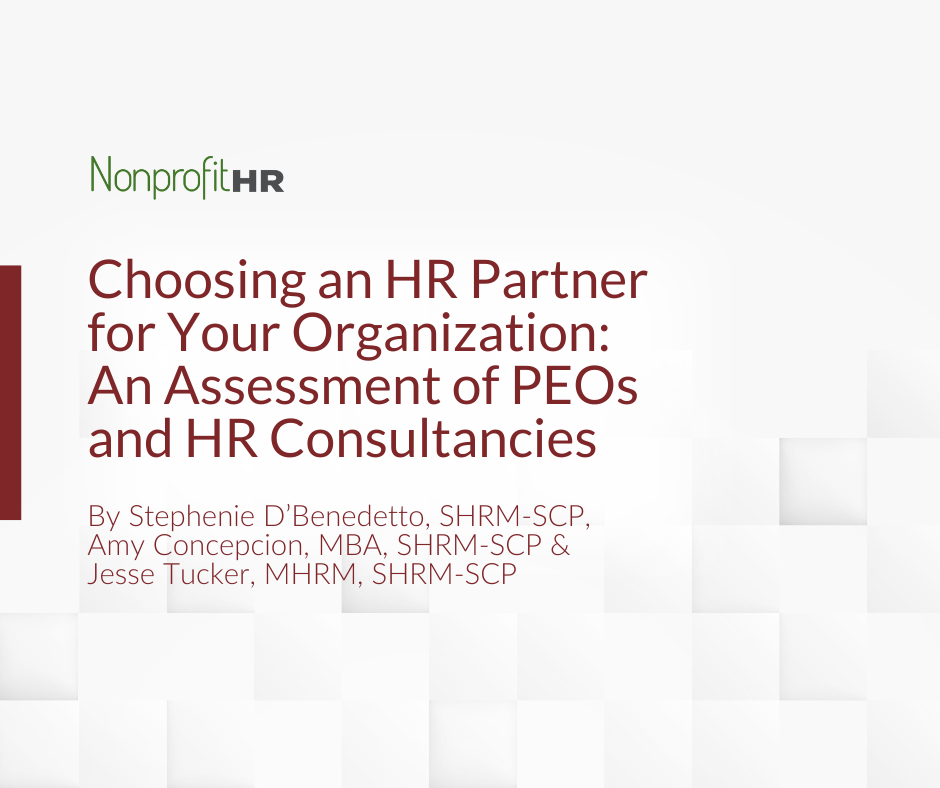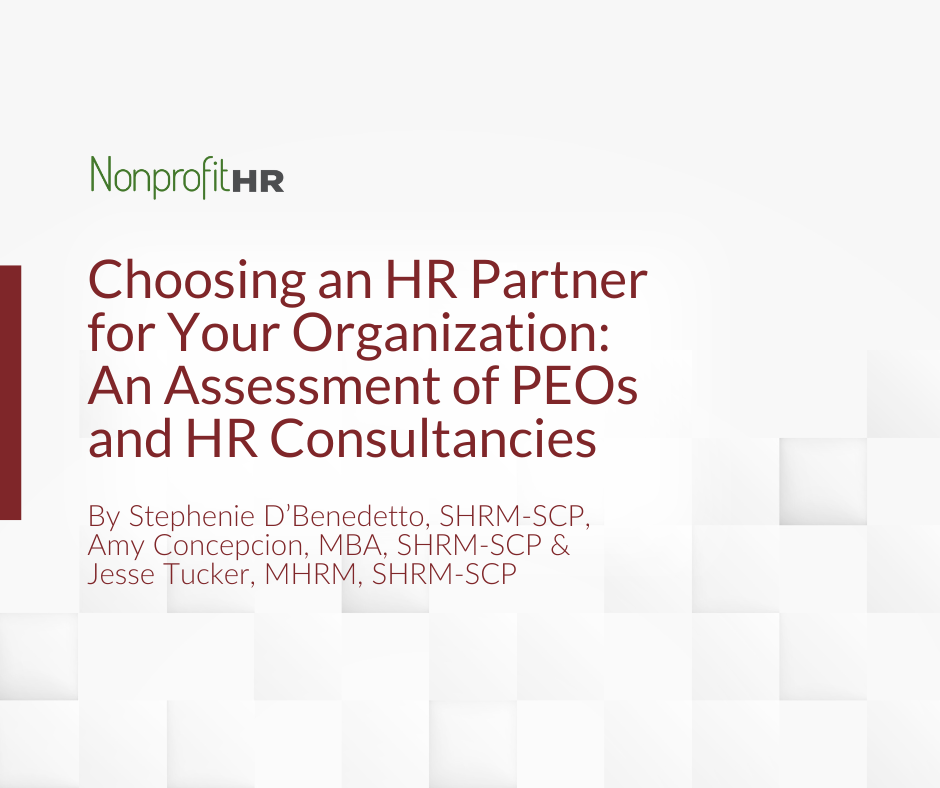 Are you looking for an HR partner for your organization, but not sure how to distinguish the options? This article will help you decide, based on your organizational needs and capacity, whether a PEO or a full HR consultancy is right for you!
Are you looking for an HR partner for your organization, but not sure how to distinguish the options? This article will help you decide, based on your organizational needs and capacity, whether a PEO or a full HR consultancy is right for you!
The main differences between the services of a PEO and that of an HR consultant, similar to what Nonprofit HR provides, are in the degrees and levels of support. PEOs will service an organization by providing the payroll function, benefits, policies and procedures; the infrastructure of your HR function. This is distinct from the HR consulting services Nonprofit HR provides, which is dedicated HR support for the full talent lifecycle.
Distinctions Between A PEO and HR Consulting Firm
1. Implementation: A PEO will support an organization by providing the systems and a basic package of policies that will automate processes and ensure compliance. However, the policies offered are often not customizable or related to the culture of the organization. As well, the organization will still be responsible for building and sustaining structures, and ensuring their staff have access to them — essentially, completing the implementation process. Ongoing long-term support through the implementation process often takes a greater scope of HR support. This is where Nonprofit HR can partner with your organization to supplement the service: to help create policies and determine how those policies apply to your culture; to interpret those laws and how they apply to your workforce; to guide and support beyond a checkbox of compliance.
2. Network of knowledge: Nonprofit HR is a fully staffed firm while a PEO typically is not. An individual PEO contact may have a large number of organizations they are responsible for advising, whereas each Nonprofit HR consultant works with only three to five client organizations at any given time. Additionally, our practice area consultants are set up in teams to ensure seamless service continuity and that our full network of knowledge is available to the client, if needed. The shared number of HR experience averages at 7-15 years for every team of Nonprofit HR consultants.
3. The system versus the service: A PEO will provide and manage HR technology, the systems your organization will use, while Nonprofit HR further provides value through people-oriented services. Our consultants get to know your unique organization, people and culture, so we can provide specific recommendations or insight that will be best suited for your organization. Our services are an enhancement of what a PEO offers from an automation and data standpoint.
In essence, an HR outsourcing partner like Nonprofit HR is a thought partner and business partner. A PEO will help with process automation, but our firm takes it a step further to provide functional support customized for your unique workplace culture. We can communicate how a certain law applies to or may affect your specific workforce and recommend best practice to not only ensure compliance, but also minimize risk and potential harm to your workplace culture.
So What Exactly is a PEO?
A professional employer organization, or PEO, is one that partners with smaller-sized organizations to provide human resource services. A PEO’s services are primarily compliance-based, offering support in ensuring employee benefits, compensation and payroll administration, workers’ compensation, and employment taxes are following appropriate regulation.
There are many reasons an organization may partner with a PEO, and each PEO can have a distinct package of service offerings. It can be a great benefit to an organization seeking basic HR support in the areas of compliance in addition to optimizing and automating many current people management practices. However, the scope of a PEOs services are limited. And depending upon your organization’s size, revenue, geography and specific needs, a strategic HR thought partner may be something that would be of greater benefit to your organization. When thinking about if this kind of partnership is right for your organization, there are a number of things to consider.
Co-Employment Model
PEOs are unique in that they use a co-employment model, unlike a traditional HR outsourcing consultancy like Nonprofit HR. This means any organization that they partner with enters a joint-employment relationship in which the employees are leased from that employer to the PEO, “thereby allowing the PEO to share and manage many employee-related responsibilities and liabilities.”
This requires the employer to have clear communication with their employees when partnering with a PEO. They need to communicate what a PEO is and why a different organization’s name may be showing up on the new hire paperwork or why they log in to a different organization’s site to get to the employee dashboard. The name of a partnering PEO may also show up on an employee’s W2 and paycheck. If your organization enters a PEO partnership, ensure your staff become familiar with the PEO and how it works to avoid any confusion.
Benefits of A PEO
Organizations that would benefit from a PEO partnership are customarily smaller organizations that are multi-state or within a state that has many local jurisdictions. If your organization has only one point of contact for HR, or someone who is not fully dedicated to the function for your organization, a PEO partnership could be beneficial to gain support structuring your HR function.
Why is this? A PEO partnership is particularly attractive to smaller organizations because they can get better health benefits. A PEO helps what would normally be considered a small employer, from a benefit-provider standpoint, better compete (in a very competitive market) with other employers that have larger benefits packages. It gives them the opportunity to make the organization more attractive to potential job candidates and supportive of existing employees who will benefit from a richer benefit package.
A PEO can be a great option even for mid-sized organizations. If you employ more than 100 employees, but you haven’t reached the threshold where benefit brokers or vendors are interested in talking to you, it can increase your ability to offer robust benefits to your employees to make sure they’re adequately supported, which can be especially important in the nonprofit space where your staff may be handling social or community situations that can affect their well-being. The PEO will go out into the market and get the best cost — discounted cost — because it functions as a large employer versus an individualized company with a smaller staff.
Another part of the value a PEO provides is specifically around HR technology. A PEO will run an HRIS system for an organization, where they’ve agreed to manage the behind-the-scenes aspects of things. In addition to having the HR platform, there’s usually additions/add-ons like ATS, performance management training videos, etc.
They can also be incredibly helpful to an organization regarding workers’ compensation, payroll and tax reporting. They manage those functions, so no one internally in the organization needs to. While there is still a responsibility on the side of the employer to verify the information that is being inputted, it’s a condensed responsibility in those administrative/operational arenas.
Serving as a general HR advisor, a PEO further helps take the how-to guesswork out of the transparency side. Your organization will be provided a dashboard or interface where employees have access to all the information across the organization, whether it’s a new-hire packet, a handbook, a time-off calendar, etc. With all that information accessible and in one place, it makes it much easier to structure, track and disseminate important information.
Performance Management Support
PEOs that offer performance management modules/support will help organizations automate and document performance management processes. They can set up for your organization a form or reminder that makes that process easier to supervisors and employees alike. You sometimes even have a performance management calendar that can provide a structure and will take the manual work out of it.
Again, a PEO will provide structure. Nonprofit HR can then support your organization in the next step of deciphering and applying that structure to your organization’s needs and goals. For example, Nonprofit HR can provide training for managers, supervisors and employees addressing topics regarding the content of performance documentation, how to provide a performance review for the first time, how to mediate any further performance and employee relations discussions, write development plans, etc.
Historical context is also an important component to consider in performance management. Nonprofit HR consultants often manage long-term engagements with clients and take into consideration all that has occurred within the organization when providing guidance. A PEO will provide a template of a performance management goal, a SMART goal for example, but they aren’t privy to all the performance discussions that have happened in the past year or perhaps what the manager’s vision of the department is, and/or other elements that may be important to bring into a performance discussion. As well, a dedicated HR consultant will screen for biases, ADA compliance, maternity leave or other circumstances that may affect goals and performance appraisals. This is typically out of the scope of duties for a PEO contact.
Four Steps To Take Before Partnering With A PEO
1. Research
Reach out to your network to see if you can gather feedback or recommendations for PEOs. As well, consider reaching out to a PEO’s clients to get real-time testimonials, if the PEO and company is willing.
2. Understand PEO response time
Another thing to understand before partnering with a PEO is the response time. That can present an issue if there is a situation, for example, with a payroll problem, which is why it is important to identify this in the research phase to establish clear expectations.
3. Evaluate your resources: time and budget
After identifying which PEO may be the best fit for your organization, turn back inward to understand your organizational budget, time and resources to dedicate to an engagement. It can take time to implement these processes and this component is key to ensuring it is done so successfully. For a successful implementation, it is recommended to allot at least 90 days and include a strategy for a communication plan and ongoing support.
4. Ongoing support/maintenance
Lastly, before entering an engagement, your organization will need a strategy and to identify a dedicated resource to manage daily/ongoing maintenance, updating workflow processes to incorporate the new system(s), adding/removing employees, inputting information updates, reporting, etc. It is important to outline and plan for how that will be continuously managed, whether internally or by partnering with Nonprofit HR.
In brief, in order to determine the best HR partnership for your organization, it is critical to do the research. You may discover you simply need a partner in establishing basic HR structures and offering competitive benefits for your staff. Or, perhaps your organization has structure in place but needs more bandwidth to guide implementation and thought partner on more nuanced HR responsibilities. This is the most important step to deeply understand your organization’s needs, priorities and available resources for an engagement. Identifying these key factors will empower you to make the best decision for your people and your mission.
Contributing Authors

